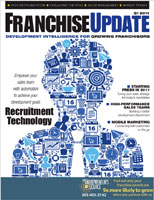Mythbusting: Separating AR Facts From Fictions
In a recent conversation with a franchisor, a comment was made that the area representative (AR) franchise expansion model is costly to implement and difficult to manage. When I asked a few questions seeking more specific details, I found that perceptions do not always reflect reality.
To dispel common misconceptions and separate facts from fiction on why some franchisors have successfully built their entire franchise system around an AR program and others feel this franchise expansion strategy is flawed, unmanageable, and costly, I have assembled some of the facts and fiction about the AR franchise expansion strategy.
Fiction: AR programs are unmanageable.
Fact: It is interesting that some of the largest franchise systems on the planet (Subway, The UPS Stores, and others) use AR as their franchise expansion strategy of choice. What's up with that? The reasons that some AR programs are difficult to manage have nothing to do with the AR strategy, but more to do with franchisors not having the right strategy or tactics in place to manage successful AR programs.
For example, too often, downsized executives who can write a big check are accepted as ARs, even though they may not have sales experience or operational acumen. Franchise companies with these franchise candidate selection criteria often are the loudest complainers and critics of AR programs. The reason is that they have unqualified ARs who are difficult to management because they are unsuccessful.
Fiction: AR is too costly.
Fact: This is a classic dilemma of the size of the pie versus the size of the slice. Is it better to have 40 or 50 percent of a $100 million revenue pie or 100 percent of a $10 million revenue pie? If franchisors do not understand this math, there is little need to continue the discussion.
In my opinion, there are only two explanations for ignoring the financial metrics of AR math. One is when a franchisor has no desire to cede any measure of control. The other is insecurities in being able to properly manage bright, aggressive, motivated, and well-capitalized ARs. This results in the Tail Wagging the Dog Syndrome--a fear that an element or group in the franchise system will become too influential. Properly structured AR programs do not have control or management issues.
Fiction: AR is only for mature franchisors.
Fact: The ideal time to implement an AR franchise expansion program is very early in the development of a franchise system. By definition this means that mature franchise systems have more difficulty implementing AR programs because they may already have single-unit franchisees in territories where they would like to award an AR territory. In fact, sometimes it is nearly impossible for mature franchisors to effectively implement an AR program.
Fiction: ARs rarely meet their development schedules.
Fact: While it is true that many ARs do not meet their development schedules the reasons nearly always lie with the franchisor. There are primary two reasons ARs do not meeting their development schedule:
- Poorly crafted development schedules that have little chance of being achieved. Often the number of franchises to be awarded over specific time periods is simply pulled out of the air. If financial incentives are properly structured, having conservative development schedules is not a problem because under-developed territories leave too much money on the table. Well-structured financial incentives and performance criteria generally resolve issues of under-developed territories.
- Franchisors having no marketing strategy to create adequate lead flow for the AR. In today's Internet centric environment, an AR can do little to generate adequate lead flow on a local basis.
When consulting with franchisors on their AR programs, I often find the lead generation strategy is to "award an AR territory, pat the AR on the back, and send them forth with a charge to 'Go and sell, my son.'" If there is no well-thought-out, organized, integrated, and aggressive lead generation funding strategy in place to ensure that there is a healthy budget in place to create an ample lead flow, it is only a matter of time before any AR program will struggle and then most likely fail.
It is not surprising that development schedules are not met, but let's be clear that the root cause generally lies with franchisors' lack of strategic vision and having a funding mechanism in place--not underperforming ARs.
Area representation is one of the most powerful franchise expansion strategies an emerging franchise system can deploy. However, there must be a thoughtful strategy and a well-executed tactical plan to create a successful AR program.
The next time you hear accusations that AR programs are generally unsuccessful, ask a few questions, and separate the facts from the fictions.
Marvin L. Storm is managing director of Blackstone Hathaway, which specializes in using area representatives as a franchise growth strategy. He can be reached at 925-376-2900 x201 or [email protected].
Share this Feature
Recommended Reading:
FRANCHISE TOPICS
- Multi-Unit Franchising
- Get Started in Franchising
- Franchise Growth
- Franchise Operations
- Open New Units
- Franchise Leadership
- Franchise Marketing
- Technology
- Franchise Law
- Franchise Awards
- Franchise Rankings
- Franchise Trends
- Franchise Development
- Featured Franchise Stories
FEATURED IN

Franchise Update Magazine: Issue 1, 2011








 The franchise listed above are not related to or endorsed by Franchise Update or Franchise Update Media Group. We are not engaged in, supporting, or endorsing any specific franchise, business opportunity, company or individual. No statement in this site is to be construed as a recommendation. We encourage prospective franchise buyers to perform extensive due diligence when considering a franchise opportunity.
The franchise listed above are not related to or endorsed by Franchise Update or Franchise Update Media Group. We are not engaged in, supporting, or endorsing any specific franchise, business opportunity, company or individual. No statement in this site is to be construed as a recommendation. We encourage prospective franchise buyers to perform extensive due diligence when considering a franchise opportunity.